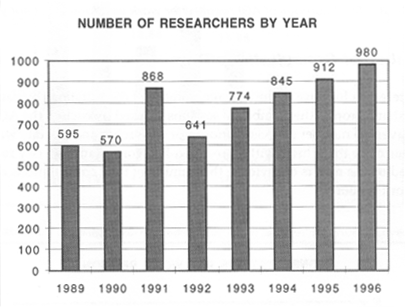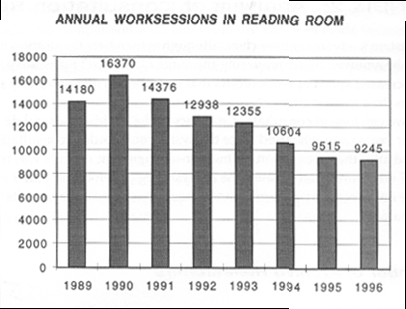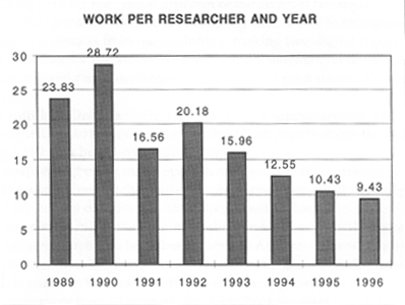For researchers, the system’s advantages are clear, although researchers themselves may be unaware of them. They may even be annoyed by surrendering the almost “fetishist” pleasure of touching the document. Still, the increased speed of work offsets that loss. We can unequivocally say that today’s researchers require less time to do their work.
To illustrate this, we can look at consultation statistics in the Archivo General de Indias from 1989 to the end of 1996. Earlier years cannot be used since the system of recording consultation data then differed from the one employed after the first version of the user-management module was implemented in mid-1988. In addition, 1997 was eliminated because the analysis began before the year’s end, and it was not possible to extrapolate data because the number and frequency of researchers’ visits vary with the time of year and school schedule.
Increase in Number of Archivo Researchers

Table 2. Researchers visiting the Archivo in recent years
The most obvious feature of Table 2 is the overall steady increase since 1990 in the number of different researchers visiting the AGI. The “spike” in researchers in 1991 can be explained by the series of celebrations held in 1992. Many research projects were being completed in 1991 in preparation for the celebrations, while for much of 1992 it became very expensive to stay in Seville because of Expo 92.
Fewer Reading Room Work Sessions
In contrast, Table 3 shows a steady drop in the number of work sessions held each year by researchers at the AGI.

Table 3. Total number of AGI researcher work sessions in recent years
Increase in Number of Consultations/Day
This period also registered an increase in the average number of consultations by each researcher during a work session and a sharp drop in the number of sessions worked by each in the AGI. In the years before computerization, the average number of consultations per researcher and per day was just over two. As of 1993, however, it was more than three, with four-and-a-half consultations a day recorded in 1996 and 1997. See Table 4, based on the results of dividing the number of total consultations each year by the number of visits or work sessions.

Table 4. Average consultations per researcher per work session
Fewer Work Sessions per Researcher
Other data show that the researcher spent much less time on average working in the AGI. Table 5 shows the progressive decline in recent years in the number of work sessions averaged by each researcher. The curve is extremely significant: work sessions per researcher dropped to fewer than half between 1992, the last year of manual consultation, and 1996, and no other reasons have been found to account for that decline. Hours of operation have remained the same and the number of reproductions delivered at the request of researchers has not risen much, yet the number of individual researchers visiting the Archivo has increased considerably.

Table 5. Average work sessions or visits per researcher and year
Conclusions
The conclusions that can be drawn from the tables relate to the greater facility for research offered by the system : more individual researchers visit the Archivo, and yet there are fewer work sessions. Why? Because in each work session the researcher has access to more information and can consult more documents. These advantages can be analyzed in two areas: ease of finding documents and the ability to consult many on-screen.
- In the first instance, the information search is more rapid using the computerized system than using printed finding aids. The new system furnishes tools for easier, more rapid retrieval of data and much faster location of the original documents needed for consultation.
- The best tools are made available to researchers, and more information is provided to users today than was possible with the original finding aids, so information is not only easier to retrieve, but there is also more information available for locating documents.
- It takes only one or two minutes to obtain a requested document on-screen, while it can take several to retrieve the original from stacks and deliver it to the Reading Room.
- Even if the researcher should decide to request a paper copy for subsequent consultation, service is still faster. While photocopies can be delivered to the AGI within one to several weeks, digital images are usually delivered the day following a request, or even the same day if service fee payments are expedited.
In summary, there are two key advantages of the system for consultation. First, researchers need much less time for their work. Second, while more researchers visit the Archivo, they schedule fewer work sessions because they need less time for their research. Consequently, the Reading Room is less crowded.

